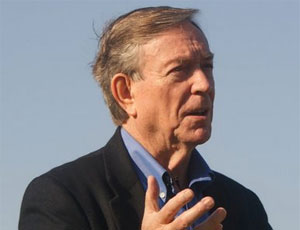 Jack Buehrer The US E.P.A. set LEED standards far too low, Anderson says. |
In the past 50 years, Ray Anderson became a highly successful, wealthy man by transforming the commercial carpet tile business. After introducing carpet tiles to North America, he started a his own company, Interface Inc. He set ambitious goals: grow the company to surpass $1 billion in annual earnings, aggressively acquire companies to give commercial carpet tiles a global reach and successfully take the company public. Now he has embarked on an even larger challenge. For the last 14 years, he’s focused on transforming carpet tile manufacturing from a wasteful, 19th Century fossil fuel-based business into a 21st Century environmentally benign closed-loop system drawing upon renewable raw materials.
ENR: Starting in 1994, you moved Interface toward a sustainable business model. How has the effort been going?
Ray Anderson: I believe in measuring things. You can’t tell how you’re doing unless you can measure it. Since we set a baseline in 1996, our plants’ greenhouse gas emissions have declined by 82%. Our sales are up by two-thirds. And profits have doubled. Going after greenhouse gases has not been bad for business. Incidentally, that 82% is roughly equal to the reduction needed for this whole technosphere, of which we’re all a part, by 2050 if we’re going to avoid serious climate disruption. The point is, it’s possible. You say, where do we start? It’s like eating an elephant, you do it one bite at a time.
ENR: President Clinton appointed you to the Sustainability Council in 1997. You and former Sen. Gary Hart (D-Colo.) have produced a energy policy position paper recommending steps to take during the first 100 days of the new administration. But there are those who believe that the U.S. has not really had an energy policy for the past eight years.
RA: Under Bush, we’ve had an energy policy that favors fossil fuels instead of where we need to be in the future. No idea how much that has cost us. It’s cost us in time in big ways. (NASA climate scientist) James Hansen believes we’ve already passed the point of no return. We’ve got to somehow get back to a level of greenhouse gas emissions where we were 10 years ago. That means bending an upward curve in the rate of emissions into a downward curve.
No matter which (candidate) wins, we’ll have a more enlightened energy policy.
ENR: Both candidates have proposed drilling for more oil. You’re trying to transform an industry heavily dependent on petroleum into a closed-loop system that requires no more virgin oil. Is there a disconnect?
RA: If we admit to an addiction, we wean the addict from drugs. You don’t give him more. That’s where we are today. We don’t need more oil. We need to figure ways to get by with less and less and less oil. At Interface we’ve made enormous strides. About a third of the reduction in emissions is though improved efficiencies. Next is deploying renewables. They’re becoming more cost-competitive with every passing day.
ENR: Does LEED (Leadership in Energy and Environmental Design) help?
RA: LEED is not nearly ambitious enough. We talking about operating a company with a zero footprint and taking from the earth only that which is rapidly and naturally renewable. Not another fresh drop of oil in a petroleum-intensive industry like ours. Compare that LEED Platinum, the highest standard...We have a long way to go. I tell (U.S. Green Building Council President) Rick Fedrizzi: “When you get to LEED 99.0, then you’re getting there.” But we really have come a long way.
ENR: How do you summarize the business case for sustainability?
R.A.: First of all, our costs are down, not up. Waste elimination alone put something like $370 million of avoided costs in our pocket. We’re on the path to eliminate waste.
The second thing: our products are the best they’ve ever been. When product design is done through the lens of sustainability it opens wellsprings of innovation. We’re producing products today that we would never have dreamed of 10 years ago.
Our people are galvanized around this shared higher purpose. Maslow said a long time ago that people need to feel like they’re working toward something that’s bigger than themselves. That’s exactly what the whole sustainability initiative has amounted to for our people.
No amount of advertising, no slick marketing campaign with any amount of money behind it could have generated the results we’ve gotten with sustainability practices.
There’s an analogue to each of those in the construction industry. Waste elimination. That’s radical, revolutionary. You end up with a better building, a better product. The galvanizing effect on people – that’s the same anywhere. Goodwill in the marketplace – everyone wants to enjoy the goodwill of his customers. The business case applies right across the spectrum.

Post a comment to this article
Report Abusive Comment